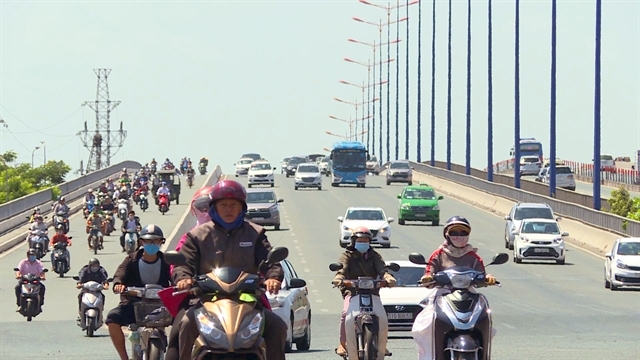 |
|
Urban heat islands make HCM City hotter.
|
The Centre for Regional and Urban Studies said this year is forecast to be the hottest ever since temperatures began to be recorded in 1880.
In large cities like HCM City and Hanoi, temperatures reached 40-50 degrees Celsius in March and April.
Dr Dương Thị Thúy Nga, head of the department of environmental informatics at the Vietnam National University HCM City-University of Science, said temperatures in several central areas in HCM City were higher than in the outskirts and rural areas.
Speaking at a forum on urban heat islands held in the city earlier this week, she said: “Because the former has a lower vegetation cover index than the latter.”
In urban areas, high-storey buildings block winds and reduce convection, she said.
The increasing number of people and vehicles and the CO2 they discharge contribute to urban heat islands, she added.
A study done by researchers at the HCM City University of Technology found that the surface temperature difference in the city had increased between 1995 and 2015 and in that period the total area of heat islands has increased four-fold.
An extreme heat island in the inner city has an area approximately 18 per cent of the city.
The researchers extracted the surface temperatures in the city’s north from Landsat satellite.
Nga said: “The urban heat island has affected people’s health and economic development and tourism in the city. A clean and beautiful city with a lot of green spaces is always attractive.”
Moreover, when it is very hot, people feel tired and their productivity is reduced, she said.
A system for monitoring and analysing surface temperatures in the city should be set up for authorities and people to realize the changes and seek solutions, she added.
Phạm Trần Hải, deputy head of the department of urban management studies at the HCM City Institute for Development Studies, said many countries in the world face the problem but have found solutions.
Singapore, for example, is increasing its open green spaces and planting more trees along high-speed roads and streets to reduce urban temperatures, he said.
The green coverage rate in Singapore is 56 per cent while in HCM City it is 18 per cent, he said.
In May several public buses with plants installed on their roofs, claimed to be the first in Asia, began plying there.
Green roofs and green walls are common in Singapore and these help reduce urban heat islands, Hải said.
It has been subsidising the cost of these roofs and walls by 50 per cent since 2009, he said.
Green roofs should be installed on buildings in HCM City too because they also help reduce the rain flowing down into the streets, he added.
Cham islanders struggling with fresh water shortage
Thousands of people in Cu Lao Cham or Cham Islands in the central province of Quang Nam are facing the severe fresh water shortage amid the hot weather.
Le Thi Nhut, a local resident, said she had to get up at around 3 am to take water from a mountainous area which is some three kilometres from her home.
Over the past four days, the water tank in Bai Bim area has almost dried.
Vo Phuc Sinh’s family is in the same situation. Every day, he has to come to the mountain to wash and then transports water home.
According to Ngo Tan Hung, vice chairman of Tan Hiep Commune, the islands are suffering from long droughts which have worsened the lack of water.
Meanwhile, the high number of visitors means more pressure on the islands’ environment, including the islands limited fresh water supply in the summer, litter, sewage, and exhausting seafood resources.
Over recent days, the water tank in the Bai Bim area was temporarily closed so that local authorities can check whether any problems happening to the water pipelines.
Tran Thi Hong Thuy, director of the Cham Islands Marine Protected Area (MPA), said that around 2,500-6,000 visitors arrive on the islands per day, compared to the 3,000 tourist capacity. Local authorities are trying to limit the number of people on the islands to ease the issues the locality is facing.
VNS
 Urban heat islands in HCM City and other large cities in Vietnam are causing heat waves with some of the highest recorded temperatures ever in the country, affecting public health.
Urban heat islands in HCM City and other large cities in Vietnam are causing heat waves with some of the highest recorded temperatures ever in the country, affecting public health.